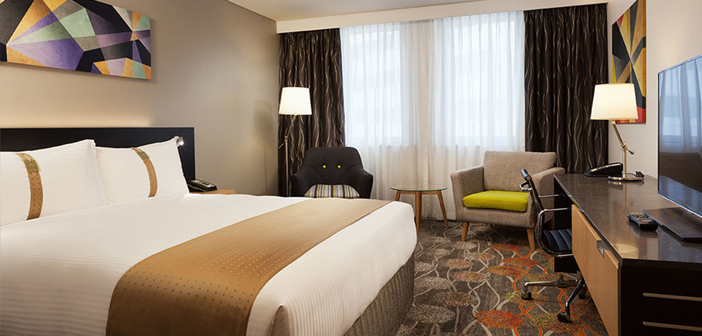Small updates can represent the best opportunities for immediate returns.
By Larry Mogelonsky, MBA, P.Eng.
There are many indicators that might tell you it’s time to renovate. Your TripAdvisor scores are dropping with guest complaints skewing increasingly towards facilities and maintenance rather than service. Or say you just received a conditional score on your annual inspection. It can even be as obvious as the faded green floral wallpaper that used to match the emerald porcelain tiles or the white shag carpeting now sporting various shades of gray.
The wear and tear on hotels far exceeds that of a personal residence. You might repaint rooms in your home once every decade depending on taste or changes in family needs. In the hotel business, though, that schedule would be seriously inadequate. Bedrooms, lobbies, hallways and the outside areas closest to the front door are under continuous guest scrutiny.
Of course, CAPEX funds for renovations are always tight. Most budgets are built around covering yearly overhead and variable costs, while large, one-time expenditures without immediate payouts are far harder to justify. The issue now is how to get the most ‘bang for the buck’ so your next round of renovations is both satisfactory in its overall goal of pleasing guests and cost-effective enough to get all decision makers on board.
Renovations can be lumped into two basic categories: light and complete. Determining which suits your current needs is a good first step. This article is dedicated to the light category, as it is the type of renovation program you will experience most often as well as the one that represents the best opportunity for immediate returns.
Putting lipstick on a pig?
You may have heard this expression before. It is used to describe superficial or cosmetic changes in an attempt, often futile, to disguise the true nature of a product.
In hotel parlance, this expression would describe a situation where the infrastructure requires a substantial rebuild (HVAC, windows, doors, bathroom fixtures and the like), but the renovation budget is limited merely to surface decoration and soft goods. While this predicament happens from time to time, light renovation does not generally include any of these above-mentioned elements.
Getting underway with any project of a capital nature starts with the establishment of a clear set of objectives and priorities. Define what is most critical, based upon you and your team’s personal inspections, as well as feedback from online review websites or in-person conversations with guests. External auditors or consultants are also available to help you identify what’s most critical. From this data-sourcing exercise, establish an ordered priority list of every element you want to address.
Defining a priority ranking at the onset will ensure nothing is left out and the most important issues are promptly addressed. In this ranking, don’t forget to include lobby, hallways, F&B outlets, fitness facilities, meeting rooms, engineering spaces or safety-related hazards. Make copies of your architectural plans; you will need them for planning purposes. It might also be prudent to ensure that any local work permits are applied for in advance.
Then comes budgeting. There is not any real guideline to go by, as the amount you will require will vary by building style, age, timelines, lead time for procurement and the extent of renovations required. In managing several ‘soft’ renovations, I have experienced a wide range of prices, so be realistic.
By establishing an ironclad priority list first, it will become readily evident that some of the items of lower priority just won’t make the cut. If you own or manage a branded property, it makes sense to follow the brand’s guidelines and seek its input, as in many instances it can provide some support services. Lastly, set aside a contingency of at least 5 percent to 7 percent of budget because changes and surprises are always a part of the process.
Seek professional support early
I realize that your spouse is a brilliant decorator. Or perhaps you have a relative who has completed a few years of school for just this job. But this is not the time to skimp on professional design services.
A competent hotel-oriented interior designer will not only be able to match colors, patterns, surfaces and textures, but also provide exceptionally cost-effective sources for all the materials that you will require. I have witnessed, firsthand, remarkable procurement cost savings generated through a designer’s offshore contacts and bulk buying capabilities. Alternatively, many designers are now highly adept at recruiting local talents at a discount so your refurbishments also engage the community. In other words, you’ll pay a fee for this level of expertise, but a good portion will be offset in lower supplier costs.
With a designer selected, form a renovations team, which, in addition to yourself, should include your executive housekeeper, your chief engineer and possibly your front desk manager. If you have a preferred contractor, you might wish to include them in the process so your installation timetable meshes with their schedules.
A cheap and cheerful checklist
Ever go to an open house in your neighborhood and wonder how the homes for sale look so perfect? Chances are the homeowners used the services of a staging company. In a way, staging a home for sale is not that much different than preparing a bedroom, lobby or hallway for guest inspection and use.
The key lesson from home staging is that first impressions are critical. Renovate with the thought of how your guest will view your property from the moment they arrive. And accordingly, below is a checklist you can use for planning a ‘cheap and cheerful’ renovation.
A) Entry and lobby
- Front door and door hardware should be new, polished and impressive. You generally do not have to replace the door. Brass hardware often can be sent for re-plating.
- Lobby carpeting is fresh and not worn. Remember, first impressions are critical.
- No torn or worn upholstery on any lobby seating areas. If seating has retained structural integrity, you may be able to recover, but often replacement is cheaper.
- LED lighting is balanced for color temperature and intensity. Take advantage of any government energy savings plans.
- A central point of interest is defined (such as a sculpture or flower vase). Create this for visual impact.
B) Hallways and elevators
- Paint is fresh, especially door frames and corners, which are prone to dings from suitcases and trolleys.
- Elevators have fresh flooring and wall panels (avoiding fake wood or metal, consider mirrors).
- Wayfaring or signage (such as guestroom numbering or that with elevators) should be clear and reflect most up-to-date branding.
- Hallway carpeting is fresh and not worn.
- LED lighting is balanced for color temperature and intensity.
C) Guestrooms
- Paint is fresh (always your best return).
- Bedspreads and bed skirts are new and selected with proper color contrast in mind.
- TV monitors are reasonably large (minimum of 50” unless there are space limitations).
- Guestroom carpeting is fresh and not worn, while the preferred move to wood or laminate flooring may go beyond the scope of this minimal cost budget.
- Drapes and sheers track well and in perfect alignment.
- Chair upholstery is relatively modern in appearance and not frayed (often case goods can be replaced at a lower cost than reupholstering charges).
- LED lighting and light shades are balanced for color temperature and intensity.
- Lamps have a contemporary appearance.
- Alarm clocks are modernized with built-in USB and phone charging sockets.
- Framed paintings and posters are updated to create a striking mood.
- Mattresses and box springs are comfortable and without serious defects (an expensive modification, so consider padded mattress cover add-ons).
D) Bathrooms
- Paint is fresh with interesting highlights (wallpaper isn’t recommended here as humidity will often lift its edges).
- LED lighting is balanced for color temperature and intensity, and is selected in the appropriate hues to be flattering for your guests.
- Bathtubs and showers should have clean tiles without presence of mold (resist plastic inserts, and look for what you can do with proper cleaning, grout and caulking) as well as a quality curtain or liner.
- Shower heads have the right temperature and volume control units (these require minimal installation time and are instantly palpable by guests).
- Flooring must be perfect with matched tiles throughout and particular attention given to edges and caulking.
- Amenities should be enhanced to meet current trends (such as adding oversized towels, improved soaps or extra-soft bathrobes).
E) Fitness center
- Equipment doesn’t have any rust and plastic items are devoid of chips or cracks.
- LED lighting is balanced for color temperature and intensity (and not set up like a surgical operating theater). Lighting is different here than guest rooms.
- Flooring matches area’s primary purpose (such as cost-effective rubberized matting).
- Paint is fresh with interesting highlights to amplify mood.
Conclusions
I’ve intentionally left out other locations such as restaurant outlets, meeting rooms and back-of-house requirements from the checklist above. This is because nothing in these areas is ‘cheap and cheerful,’ and there are many other issues to further complicate these revitalization efforts.
Depending upon the extent of the renovations, though, you can quite literally change your property’s marketplace presence. One property I recently visited was transformed from ‘old and tired’ to ‘new and trendy’ through a reimagined design sense that was delivered via a new color set, soft goods replacement and some strategic hard-goods upgrades. The end result was a $20+ ADR increase, and all for a bargain upfront cost!
Reminiscing a bit further, one of my earlier experiences in property renovation was a two-year project for a 550+ room resort. With seasonal occupancies, work could only be tackled in the winter months. The first year’s program entailed the guestrooms, with the public areas addressed the following year. Whereas the schedule seemed logical, the key lesson learned was that because common areas get more ‘eyeballs’ than guestrooms, to the general public the hotel had only really renovated when the lobby was updated.
Even now, some 30 years later, this still seems to make a lot of sense. These ‘cheap and cheerful’ upgrades are designed to elevate appearances to reflect and fall in sync with the reality of how good your services and guest experience actually are. ■
Larry Mogelonsky is the owner of Hotel Mogel Consulting Limited. His experience encompasses hotel properties around the world, both branded and independent, ranging from luxury and boutique to select-service. He can be reached at [email protected].




